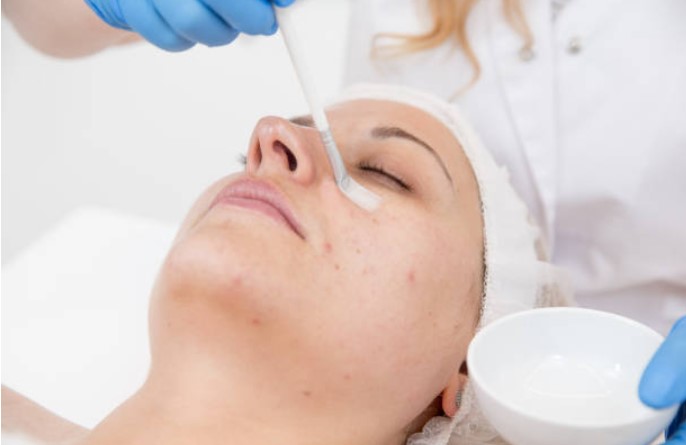Unlocking Radiant Skin: The Power of Chemical Peel Peeling

Chemical peels have gained immense popularity in the world of skincare for their ability to rejuvenate the skin, diminish imperfections, and enhance overall complexion. Chemical peels are a group of cosmetic treatments that use various acidic solutions to exfoliate the outer layers of the skin, leading to improved texture and appearance. This article explores the transformative benefits of chemical peel peeling, with a particular focus on how it can address issues such as acne scars.
What Is Chemical Peel Peeling?
Chemical peel peeling involves applying a chemical solution to the skin, which causes the outer layers to exfoliate and eventually peel off. This process reveals a fresher, smoother layer of skin beneath. Chemical peels can be tailored to treat various skin concerns, including wrinkles, uneven skin tone, and acne scars.
Types of Chemical Peels
- Superficial Peels: These use mild acids like glycolic or salicylic acid to target the outermost layer of skin. They are ideal for improving skin texture and tone, and they often require minimal downtime.
- Medium Peels: Employing stronger acids like trichloroacetic acid (TCA), medium peels penetrate deeper than superficial peels. They are effective for treating more pronounced skin issues such as moderate wrinkles and pigmentation irregularities.
- Deep Peels: These peels reach the deepest layers of the skin using potent chemicals like phenol. They are used for more severe skin concerns, including deep wrinkles and extensive sun damage, but they involve a longer recovery period.
Benefits of Chemical Peels
The benefits of chemical peels extend beyond merely enhancing the skin’s appearance. They offer a range of advantages that make them a popular choice for many individuals seeking skin rejuvenation. Apart from these treatments, you can also try supplements with milk thistle amazon and biotin.
Improved Skin Texture
Chemical peels work by removing the outer layers of damaged skin, which can lead to a significant improvement in skin texture. This makes the skin feel smoother and look more even. The removal of dead skin cells also helps in promoting the growth of new, healthier skin cells.
Reduction in Fine Lines and Wrinkles
By stimulating collagen production and promoting skin regeneration, chemical peels can help reduce the appearance of fine lines and wrinkles. This effect is particularly pronounced with medium and deep peels, which penetrate more deeply into the skin.
Enhanced Radiance and Glow
Chemical peels can revive dull, tired-looking skin by removing surface imperfections and promoting a brighter complexion. Regular treatments can lead to a more radiant and youthful appearance, enhancing overall skin health.
Treatment for Acne Scars
One of the standout benefits of chemical peels is their effectiveness in treating acne scars. Chemical peel for acne scars specifically targets the pigmentation and textural irregularities left behind by acne. By removing damaged skin layers and stimulating new cell growth, chemical peels can significantly improve the appearance of acne scars.
Read also: Transforming Healthcare: The Role of Medical Device Software Development Companies
How Does Chemical Peel Peeling Work?
Understanding the process of chemical peel peeling can help set realistic expectations and prepare you for the treatment.
Consultation and Assessment
Before undergoing a chemical peel, a thorough consultation with a skincare professional is essential. During this consultation, the provider will assess your skin type, discuss your goals, and recommend the most suitable type of chemical peel for your needs.
The Procedure
- Cleansing: The skin is cleansed to remove any impurities and ensure that the chemical solution adheres properly.
- Application: The chemical solution is applied to the skin. Depending on the type of peel, you may feel a tingling or burning sensation, which is normal.
- Neutralization: Some peels require neutralization to stop the chemical reaction. This step ensures that the peel does not penetrate too deeply and helps control the intensity of the treatment.
- Post-Treatment Care: After the peel, the skin may be red and sensitive. Your provider will offer specific aftercare instructions to help you manage recovery and optimize results.
Recovery and Results
Recovery time varies depending on the depth of the peel. Superficial peels typically involve minimal downtime, while medium and deep peels may require several days to a week for healing. It is crucial to follow the aftercare instructions provided by your practitioner, including moisturizing, avoiding sun exposure, and using gentle skincare products.
Finding the Right Chemical Peel for Your Needs
Choosing the right chemical peel involves considering several factors to ensure you receive the best possible results.
Expertise and Experience
Select a clinic or skincare professional with extensive experience in performing chemical peels. Their expertise will ensure that you receive a treatment tailored to your specific skin type and concerns.
Quality of Products
The effectiveness of chemical peels largely depends on the quality of the products used. Reputable clinics use high-quality chemical solutions to achieve optimal results and minimize risks.
Personalized Approach
A personalized approach is essential for achieving the best results. Your skincare provider should assess your skin’s condition, discuss your goals, and recommend a peel that aligns with your needs.
Cost and Accessibility
While cost can vary, many clinics offer financing options or payment plans to make chemical peels more accessible. Consider the cost in relation to the clinic’s reputation, the quality of products used, and the expected outcomes.
Embracing the Results
Chemical peel peeling is a powerful skincare treatment that offers numerous benefits, from improving skin texture to reducing the appearance of acne scars. By choosing the right type of peel and working with a skilled professional, you can achieve a smoother, more radiant complexion.
Chemical peel for acne scars can be particularly transformative, helping to diminish the visibility of scars and restore a more even skin tone. With proper care and a commitment to following aftercare instructions, you can enjoy the long-lasting benefits of a chemical peel and reveal healthier, more vibrant skin.
FAQs
How many sessions of chemical peel are needed for optimal results?
The number of sessions required depends on the type of peel and the specific skin concerns being addressed. Superficial peels may need to be repeated every few weeks, while medium and deep peels might be performed less frequently, based on individual needs and goals.
Is there any downtime after a chemical peel?
Downtime varies depending on the depth of the peel. Superficial peels typically require minimal downtime, while medium and deep peels may involve several days of recovery. Follow your provider’s aftercare instructions to ensure a smooth healing process.
Are chemical peels safe for all skin types?
Chemical peels are generally safe for most skin types. However, individuals with sensitive skin or specific skin conditions should consult with a skincare professional to determine the most suitable peel and ensure safety.
What should I avoid after a chemical peel?
After a chemical peel, it is essential to avoid sun exposure, as the skin will be more sensitive to UV rays. Additionally, refrain from using harsh skincare products or exfoliants until your skin has fully healed. Follow your provider’s recommendations for post-treatment care.
Chemical peel peeling offers a remarkable opportunity to enhance your skin’s appearance and address a variety of concerns. With the right approach and a skilled professional, you can unlock the full potential of this effective treatment and enjoy a more radiant, youthful complexion.



